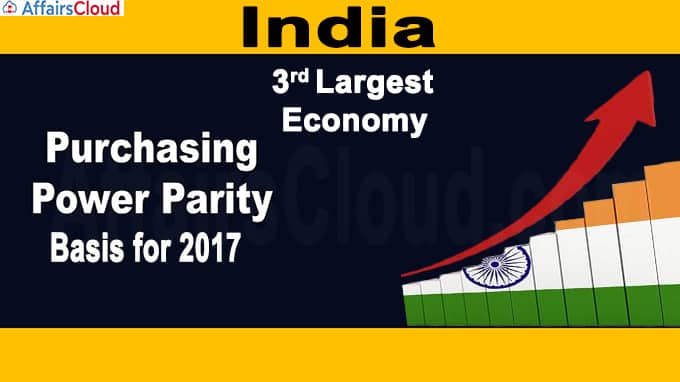 In accordance with the World Bank Data under the International Comparison Program (ICP), revealed by India’s National Statistical Office (NSO) of Ministry of Statistics & Programme Implementation (MoSPI), India has retained its position as the third-largest economy in terms of purchasing power parity (PPP) for 2017 as it accounted for 6.7% or $8,051 billion out of world total of $119,547 billion of global Gross Domestic Product (GDP).
In accordance with the World Bank Data under the International Comparison Program (ICP), revealed by India’s National Statistical Office (NSO) of Ministry of Statistics & Programme Implementation (MoSPI), India has retained its position as the third-largest economy in terms of purchasing power parity (PPP) for 2017 as it accounted for 6.7% or $8,051 billion out of world total of $119,547 billion of global Gross Domestic Product (GDP).
- India has followed China (16.4%) and the United States-US (16.3%) which ranked 1st and 2nd respectively.
- On the other hand India is followed by Japan, Germany, and the Russian Federation at 4th, 5th and 6th position respectively.
Other Ranking of India
–Global: India is the 3rd largest economy in terms of its PPP-based share in global actual individual consumption (AIC) and global gross capital formation (GCF).
–Asia Pacific Region: India is also the second-largest economy accounted for 20.83% in terms of its PPP-based share in regional AIC and regional GCF where China was at 50.76 per cent (first) and Indonesia at 7.49 per cent (third).
Factors behind India’s 3rd ranking in terms of PPP
– The PPPs of Indian Rupee per US$ at GDP level is now 20.65 in 2017 from 15.55 in 2011.
-The exchange rate of a dollar to a rupee rose to 65.12 from 46.67 during the period of 2011-2017.
–Price Level Index (PLI), the ratio of a PPP to its corresponding market exchange rate, which is used to compare the price levels of economies, improved to 47.55 in 2017 from 42.99 in 2011.
What is PPP?
It states that exchange rates between currencies are in equilibrium when their purchasing power is the same in each of the two countries. For example- How much milk that Rs 75 can purchase in India and One Dollar can purchase in the US. On this basis (PPP) the GDP of India is measured.
Point to be noted:
Overall 19 economies, representing nearly 64% of the global population, contributed three-quarters of global GDP.
- Three of these economies (India, Indonesia, and the Arab Republic of Egypt) were classified as lower-middle-income economies and six (China, the Russian Federation, Brazil, Mexico, Turkey, and the Islamic Republic of Iran) were classified as upper-middle-income economies, with the remainder classified as high income economies.
About ICP:
The World Bank released new PPPs for the reference year 2017, under the International Comparison Program (ICP) that adjust for differences in the cost of living across economies of the world. Globally, 176 economies participated in the 2017 cycle of ICP.
- The ICP is the largest worldwide data collection initiative, under the guidance of United Nations Statistical Commission (UNSC).
- The next ICP comparison will be conducted for the reference year 2021.
About World Bank:
Headquarters– Washington, D.C., United States
Member Countries– 189
President– David Robert Malpass
About MoSPI:
Minister of State (Independent Charge)– Rao Inderjit Singh




